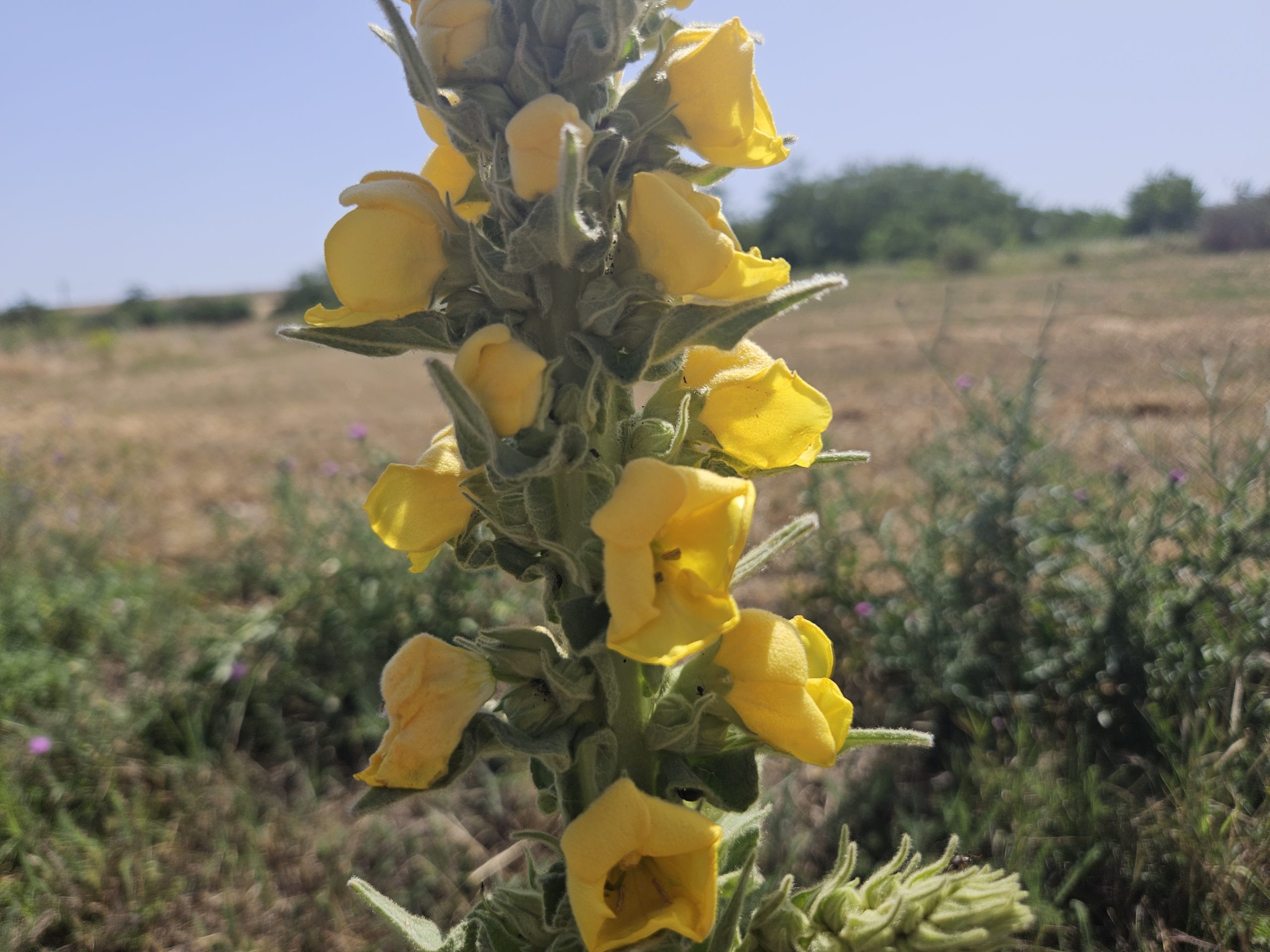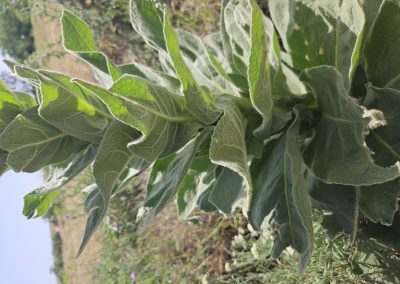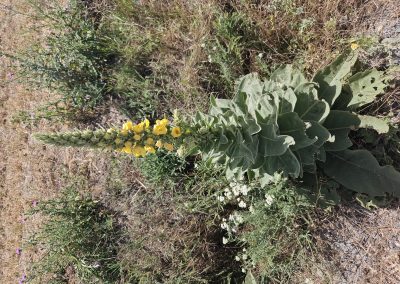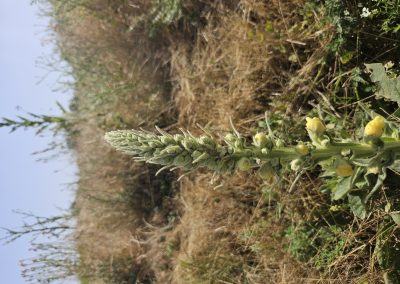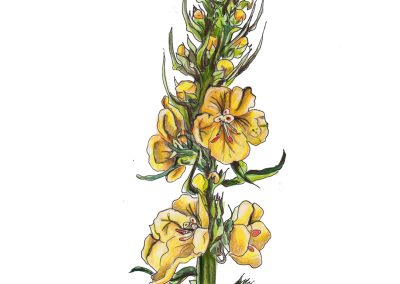Verbascum densiflorum
Scientific description
Phylum: Angiospermatophyta (Magnoliophyta)
Class: Dicotyledonatae (Magnoliatae)
Subclass: Asteridae
Order: Solanales (Scrophulariales)
Family: Scrophulariaceae
Common name: Mullein, Great Mullein
Origin: European.
Description:
Biennial herbaceous plant, abundantly hairy with long, branching gray or yellowish-gray hairs, 50–100 cm tall. Taprooted and branched root. Stem tall, hairy. Basal leaves elongated-elliptic, petiolate in rosette; stem leaves ovate, short-petiolate or sessile, alternate, hairy. Flowers in long raceme, each with lanceolate bract. Long calyx, yellow corolla, androecium of unequal stamens (2 long anterior, 3 short posterior), bicarpellate gynoecium. Terminal elongated inflorescences. Fruit capsule.
Propagation: Seeds.
Ecology: Common from plain to hill areas, meadows, shrubs, uncultivated land. Prefers sunny, very dry xerophytic soils.
Uses: Traditional medicine: flower petals containing saponins, mucilages, sucrose, glucose, mineral salts, used in decoctions or infusions to calm bronchitis and intestinal issues. Expectorant, anticatarrhal, diaphoretic, diuretic, analgesic.
Hazard: Plant hairs may cause skin and eye inflammation.
Încrengătura: Angiospermatophyta (Magnoliophyta)
Clasa: Dicotyledonatae (Magnoliatae)
Subclasa: Asteridae
Ordinul: Solanales (Scrophulariales)
Familia: Scrophulariaceae
Denumire populară: lumânărică, coada vacii.
Originea: Europeană.
Descriere:
Plantă ierboasă bianuală, abundent păroasă, cu peri lungi, ramificați, gri sau gri-gălbui, 50–100 cm. Rădăcină pivotantă, ramificată. Tulpină înaltă, păroasă. Frunze bazale alungit-elliptice, pețiolate, în rozetă; frunze tulpinale ovate, scurt pețiolate sau sesile, altern, acoperite de peri. Florile în racem lung, fiecare cu bractee lanceolate. Caliciu lung, corolă galbenă, androceul cu stamine inegale (2 anterioare lungi, 3 posterioare scurte), gineceu bicarpelar. Inflorescențe terminale, lungi. Fruct capsulă.
Înmulțire: semințe.
Ecologia: Frecventă din câmpie până în dealuri, prin pajiști, tufărișuri, terenuri necultivate. Preferă zone însorite, foarte uscate, soluri xerofite.
Utilizare: Medicină tradițională: petale cu saponine, mucilagii, zaharoză, glucoză, săruri minerale; decocturi și infuzii pentru bronșite și afecțiuni intestinale. Proprietăți expectorante, anticatarale, sudorifice, diuretice, analgezice.
Pericol: Perii plantei pot provoca inflamații ale pielii și ochilor.
Φυλοταξία: Angiospermatophyta (Magnoliophyta)
Κλάση: Dicotyledonatae (Magnoliatae)
Υποκλάση: Asteridae
Τάξη: Solanales (Scrophulariales)
Οικογένεια: Scrophulariaceae
Δημοφιλής ονομασία: λυχνάρι, κοάδα της αγελάδας
Καταγωγή: Ευρωπαϊκή.
Περιγραφή:
Διετές ποώδες φυτό, πλούσια τριχωτό, 50–100 εκ., μακριές, διακλαδιζόμενες τρίχες γκρι ή γκρι-κίτρινες. Ρίζα κεντρική, διακλαδιζόμενη. Κορμός ψηλός, τριχωτός. Βασικά φύλλα επιμήκη-ελλειπτικά, με μίσχο, σε ροζέτα; φύλλα κορμού ωοειδή, μικρό μίσχο ή χωρίς, εναλλασσόμενα, καλυμμένα με τρίχες. Άνθη σε μακρύ ρακέμ, κάθε άνθος με λογχοειδή βράκτειο. Μεγάλος κάλυκας, κίτρινη κορόλη, άνισα στήμονες (2 μεγάλοι πρόσθιοι, 3 μικρότεροι οπίσθιοι), δίχωρη ωοθήκη. Τερματικές, επιμηκυσμένες ταξιανθίες. Καρπός: κάψουλα.
Αναπαραγωγή: μέσω σπόρων.
Οικολογία: Από πεδιάδες έως λοφοειδείς περιοχές, λιβάδια, θάμνους, ακαλλιέργητα εδάφη. Προτιμά ηλιόλουστες, πολύ ξηρές περιοχές, ξηροθερμικά εδάφη.
Χρήση: Παραδοσιακή ιατρική: πέταλα με σαπωνίνες, μούχιες, σάκχαρο, γλυκόζη, ανόργανα άλατα. Αφεψήματα/εκχυλίσματα για βρογχίτιδα και εντερικές παθήσεις. Αποχρεμπτικές, αντικαταρροϊκές, εφιδρωτικές, διουρητικές, αναλγητικές ιδιότητες.
Κίνδυνος: Οι τρίχες μπορούν να προκαλέσουν φλεγμονές στο δέρμα και τα μάτια.
Phylum : Angiospermatophyta (Magnoliophyta)
Classe : Dicotylédones (Magnoliatae)
Sous-classe : Asteridae
Ordre : Solanales (Scrophulariales)
Famille : Scrophulariaceae
Nom commun : molène, grande molène
Origine : européenne.
Description :
Plante herbacée bisannuelle, abondamment velue avec longs poils ramifiés gris ou gris jaunâtre, 50–100 cm. Racine pivotante et ramifiée. Tige haute, poilue. Feuilles basales allongées-elliptiques, pétiolées en rosette; feuilles de tige ovales, courtes-pétiolées ou sessiles, alternes, poilues. Fleurs en long racème, chaque fleur avec bractée lancéolée. Long calice, corolle jaune, androcée avec étamines inégales (2 longues antérieures, 3 courtes postérieures), gynécée bicarpellé. Inflorescences terminales et allongées. Fruit capsule.
Multiplication : graines.
Écologie : Commune de la plaine aux collines, prairies, arbustes, terres non cultivées. Plante préférant zones ensoleillées et très sèches, sols xérophiles.
Utilisation : Médecine traditionnelle : pétales contenant saponines, mucilages, saccharose, glucose, sels minéraux; décoctions ou infusions pour calmer bronchites et affections intestinales. Expectorante, anticatarrhale, diaphorétique, diurétique, analgésique.
Danger : Poils peuvent provoquer inflammation peau et yeux.
Creative writing inspired by Verbascum densiflorum
Written by Matei Riana-Alexandra
The Flower That Lights the Way
In a world where night and day were constantly battling to face each other, there was a plant with yellow flowers that brought light even into the darkest corners of the forests. This plant is mullein. It is said that on a dark summer evening, an old witch, known for her wisdom, found a flame that had extinguished in the middle of the forest. Believing it was her last chance to keep light in the world, she wrapped the dying flame in verbascum leaves and began an ancient ritual. After several hours, the fire rose from the ashes, leaving behind a magnificent plant with yellow flowers and a magical power to bring light in the dark.
Since then, it is said that mullein not only illuminates the dark forests, but also brings protection to those who wear it. People who grow verbascum in their gardens or near their doorstep are protected from evil spirits and find their way even in the hardest times. It is also said that, when someone is lost in the forest at night, a faint light shining through the verbascum leaves will guide their steps back home.
This plant represents not only light but also divine protection, and each yellow flower is a fragment of the fire that once lit the forests and brought them to life.


